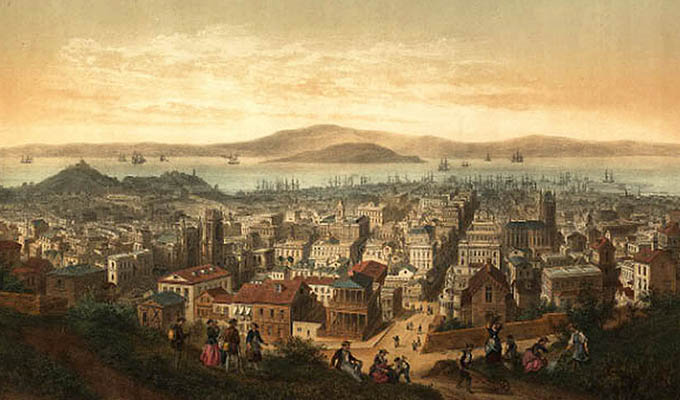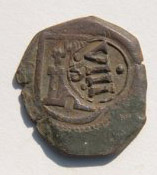Passenger Lists: San Francisco 1800s

William Melville
Arrive San Francisco
July 28, 1850
219 ton British bark
Captain George Thomas
From Tasmania
On May 23, 1850, the Daily Alta California Shipping Intelligence Memoranda included the BarqueWilliam Melville at Hobart Town on February 11, 1850, loading and sailing for San Francisco on February 22.
Passage

Left Launceston, Tasmania, March 30, 1849. On May 13, 1850, sent a boat to shore at Patersons' Group in search of water. The boat's crew were decoyed natives into the bushes on the pretense they would be shown water. They were attacked by a great number of natives. Two crewmen were killed: Francis Lacey of Hobart Town and Michael McSweeny of Ireland. Remainder of crew saved themselves by swimming off towards the ship and a boat sent to pick them up. 36 passengers, 116 days to San Francisco.
Cargo
110 opossum rugs, 1 horse (for Captain Thomas), 1 house for the Captain, flour, oats, rice, pickles, butter, bacon, medicine, tobacco, sugar, tea and onions.
May 24, 1851, Daily Alta Califoria, San Francisco
FOR SALE by the undersigned, the cargo of the barque William Melville, from Hobart Town, consisting of
- 690 Boxes onions, 1874 boxes potatoes, 177 boxes applies;
- 26 baskets apples, 113 bags barley; 219 bags oats;
- 2 bales gunny bags; 10 bales leather;
- 124 casks bottled beer, 6 doz each;
- 4 hhds leaf sugar; 100 bags Mauritius sugar;
- 100 casks molasses, 60 bxs raisins;
- 1050 bars iron; 96 bundles iron.
EDDIE BROWNE & CO
Mrs. Thomas and Child
J. M. C. Brown
J. Poolwer
D. Ritchie
Robert Towart
Mr. Hodges
Mr. and Mrs. J. Smith
W. Mariner
W. Shepperd
W. Curlew
W. Mannington
D. Wilkins
F. Martin
O. Palmer
E.J. Beecraft
Mr. Lucey
Mr. Lipscombe
J. Love
Mr. Leary
D. McWaney
E. Coorley
J. Burke
T. Jenkins
R. Swain
Mr. and Mrs. French
S. Garasfork
T. Sharp
J. Crandon
D.C. O'Meara
R. Wood
R. Roberts
W. Crask
William Watson
February 3, 1851, Daily Alta California, San Francisco
Memoranda: Barque William Melville arrived at Hobarttown November 8, 1850.
Early Mapping of the Pacific: The Epic Story of Seafarers, Adventurers and Cartographers Who Mapped the Earth's Greatest Ocean
Author Thomas Suarez is a well-known authority on early maps whose previous books include Early Mapping of Southeast Asia
(Periplus, 2000), which has become a standard work in the field. He has served as curator and advisor for collections and exhibitions dealing with the history of cartography, and has been an important source for early maps for the past twenty-five years.
The Mammoth Book of Life Before the Mast:
Sailors' Eyewitness Stories from the Age of Fighting Ships
Jon E. Lewis, Editor
Firsthand accounts of the real-life naval adventures behind the popular historical sagas of Patrick O'Brian and C. F. Forester. Twenty true-life adventures capture the glory and gore of the great age of naval warfare from the late eighteenth to the early nineteenth century -- the age of the French Revolutionary War, the Napoleonic Wars, and the War of 1812 -- when combat at sea was won by sheer human wit, courage, and endurance. Culled from memoirs, diaries, and letters of celebrated officers as well as sailors, the collection includes accounts of such decisive naval engagements as Admiral Horatio Nelson's on the Battle of the Nile in 1798 or Midshipman Roberts' on the Battle of Trafalgar in 1805 and also glimpses into daily hardships aboard a man-of-war: scurvy, whippings, storms, piracy, press gangs, drudgery, boredom, and cannibalism.
Life of a Sailor (Seafarers' Voices)
Frederick Chamier
Chamier went to sea in 1809 as an officer in the Royal Navy. Like his contemporary, Captain Frederick Marryat, he enjoyed a successful literary career and is remembered for his naval novels. This book, his first, is usually catalogued as fiction, although it is an exact account of his naval experiences, with every individual, ship, and event he described corroborated by his service records. Told with humor and insight, it is considered an authentic account of a young officer's service. From anti-slavery patrols off Africa to punitive raids on the American coast during the War of 1812, Chamier provides details of many lesser-known campaigns. His descriptions of British naval operations in America, which reflected his objection to bringing the war to the civilian population, were criticized by his seniors.
The Nagle Journal: A Diary of the Life of Jacob Nagle, Sailor, from the Year 1775 to 1841
John C. Dann
Great Stories of the Sea & Ships
N. C. Wyeth
More than 50,000 copies of this collection of high-seas adventures are in print. Not only does it showcase the fiction of such classic writers as Daniel Defoe, Jules Verne, and Jack London, but the entries also feature historic first-person narratives including Christopher Columbus' own account of his famous voyage in 1492. Vivid tales of heroic naval battles and dangerous journeys of exploration to the stories of castaways and smugglers. The variety of works includes The Raft of Odysseus, by Homer; Hans Christian Andersen's The Mermaid; The Specksioneer, by Elizabeth Gaskell; Washington Irving's The Phantom Island; and Rounding Cape Horn, by Herman Melville. Eighteen extraordinary black and white illustrations by Peter Hurd add to the volume's beauty.
The Rebel Raiders
The Astonishing History of the Confederacy's Secret Navy
James T. deKay
During its construction in Liverpool, the ship was known as Number 290. It was unleashed as the CSS Alabama, the Confederate gunship that triggered the last great military campaign of the Civil War, yet another infamous example of British political treachery, and the largest retribution settlement ever negotiated by an international tribunal: $15,500,000 in gold paid by Britain to the United States.
This true story of the Anglo-Confederate alliance that led to the creation of a Southern navy illuminates the dramatic global impact of the American Civil War. Like most things in the War between the States, it started over cotton: Lincoln's naval blockade prevented the South from exporting their prize commodity to England. In response, the Confederacy came up with a plan to divert the North's vessels and open a plan that would mean covertly building a navy in Britain, a strategy that involved a cast of clandestine characters.



















 Copyright ~ 1998-2018.
Copyright ~ 1998-2018. 